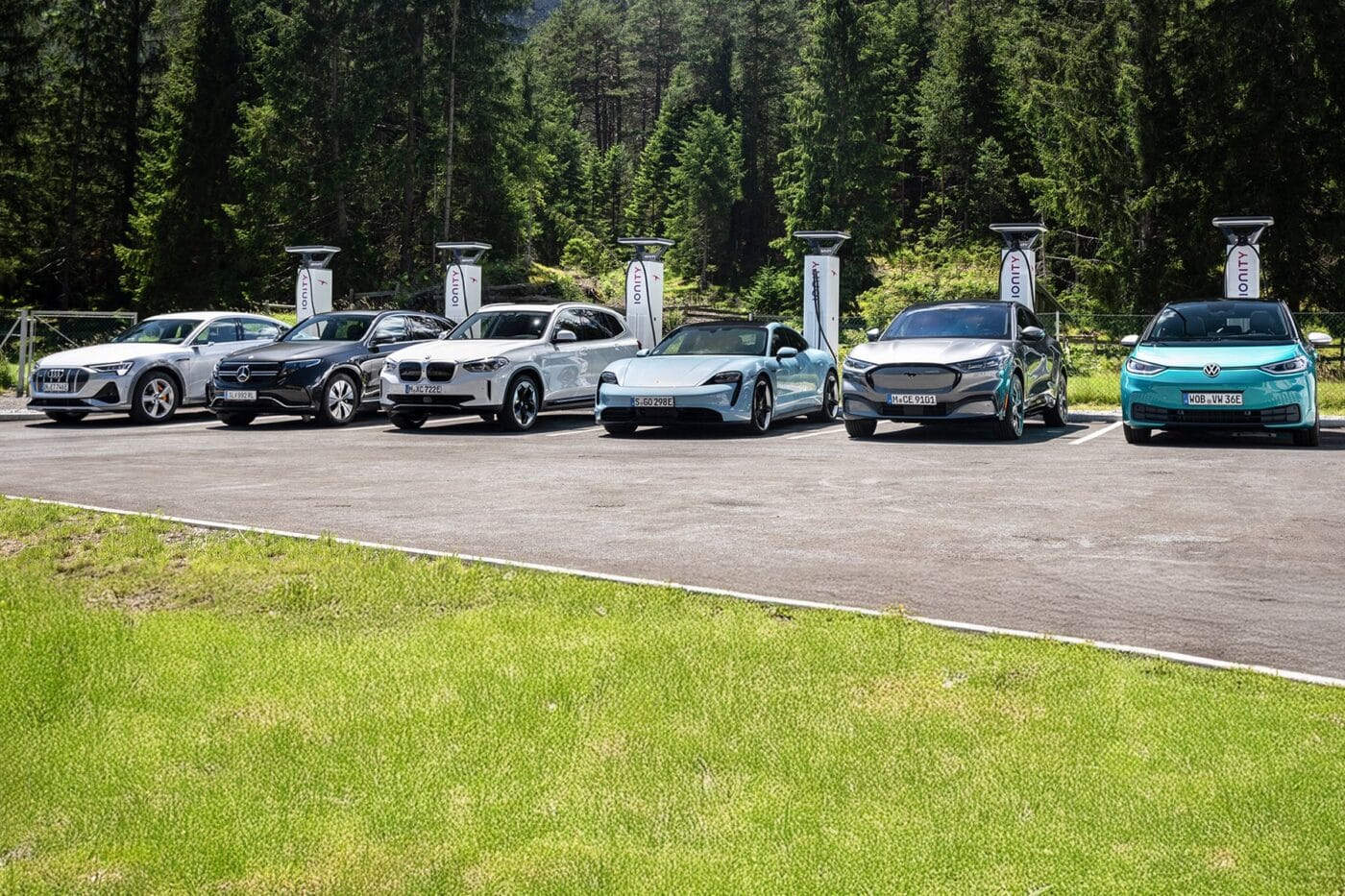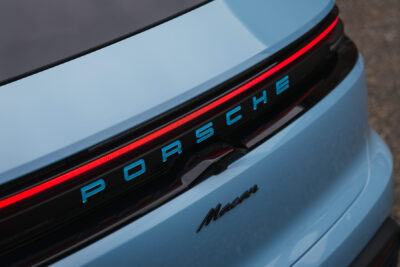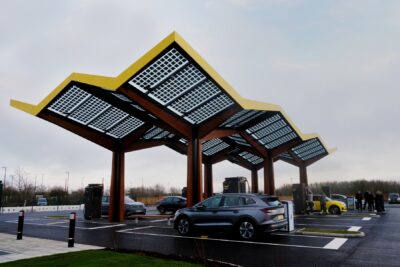
¿Qué es lo próximo para Ionity? Entrevista con el director general Jeroen van Tilburg
Posibilitar la movilidad eléctrica en largas distancias: ése era el objetivo principal de Ionity, que se fundó por encargo de varios grandes fabricantes de automóviles. Con sus estaciones de carga rápida en autopistas, Ionity debía ayudar a los accionistas del Grupo VW, Mercedes-Benz, BMW, Ford y, más tarde, Hyundai-Kia a vender sus coches eléctricos de forma más eficaz. La visión era cargar rápidamente durante unos minutos en el trayecto entre dos grandes ciudades y continuar después.
Con más de 5.000 parques de recarga en 24 países europeos, Ionity ha logrado esta parte de su misión: la recarga a larga distancia ya es posible, sólo con las ubicaciones de Ionity. Si se añaden los cargadores rápidos de otros operadores, resulta aún más cómodo. Pero, ¿qué es lo próximo para Ionity en la próxima fase?
Ionity es también miembro fundador de la Alianza Spark, un consorcio de cuatro grandes proveedores que quieren sentar nada menos que las bases de la "mayor y más fiable red de recarga pública de Europa". Hablamos con el director general de Ionity, Jeroen van Tilburg, sobre la alianza, la estrategia de futuro, el nuevo servicio de flota de Ionity y los precios de recarga.
Señor van Tilburg, hace unas semanas, Ionity fundó la Spark Alliance junto con otros tres CPO para simplificar la recarga de los vehículos eléctricos en Europa. ¿Puede describir brevemente la idea básica que subyace a la alianza? ¿Cómo surgió la alianza de estos cuatro socios?
La alianza fue formada por estos cuatro actores porque todos vimos el mismo reto en la industria. Actualmente hay muchas opciones de recarga, pero hasta el punto de que el panorama está bastante fragmentado con muchos actores diferentes, muchas velocidades diferentes, diferentes expectativas en torno a la fiabilidad y el tiempo de actividad. Diferentes tamaños de estación, diferentes formas de pago. Y eso resulta bastante confuso para mucha gente.
Hay tantas opciones que la gente se siente abrumada, especialmente si es nuevo en la propiedad de un VE. Si usted es un conductor experimentado de VE, probablemente conozca el camino, sepa cómo ajustar su comportamiento. Está familiarizado con la diferencia entre la carga de CA, CC y HPC. Pero con esta próxima oleada de adopción del VE, tenemos que asumir esa responsabilidad a la hora de aportar claridad. Hace unos años, todo el mundo se lanzó a esta nueva industria de la recarga como en la fiebre del oro. Compañías energéticas, petroleras u otros actores que tratan la recarga como un trabajo secundario, sin convertirla en su negocio principal.
Pero en la Alianza, todos somos CPO puros, operadores de puntos de recarga. Es nuestro negocio principal. Es nuestro pan de cada día y nuestro negocio depende de ello. Nos hemos encontrado de forma natural porque compartimos muchos valores y nos consideramos líderes en este sector. Así que hemos creado la Spark Alliance como marca de calidad.
Permítame ponerle un ejemplo: Si quiere comprar un televisor nuevo y va a la tienda de electrónica local, hay cientos de televisores en la tienda. No sabe cuál elegir. Todos tienen el mismo aspecto. Algunos son más grandes, otros más pequeños, pero con todos podrá ver la televisión. Lo que puede ayudarle en su decisión es una marca como Dolby Atmos o THX. No tiene por qué conocer todos los detalles técnicos, pero sabrá que este televisor ofrece la calidad que busca.
¿Pero no es como el mismo problema de lo que usted ha descrito que un conductor de VE experimentado sepa cosas como CA, CC o qué CPO es de alta calidad? Los nuevos usuarios ven aplicaciones itinerantes con 800.000 puntos de recarga o más. Y eso les parece bien. Entonces, ¿en qué se diferenciará la Alianza Spark de las plataformas de itinerancia estándar? ¿Y cómo se dará a conocer con los valores que ha descrito?
La Alianza no pretende sustituir a las plataformas itinerantes ni a los MSP. Las MSP proporcionan un acceso sin fisuras a CA, CC y HPC. Nosotros somos esencialmente actores de HPC.
Y animamos a nuestros socios MSP a adoptar la Alianza como una marca de calidad dentro de sus ofertas. De entre el millón de puntos de recarga que hay en toda Europa, ¿cuál debería elegir para disfrutar de una buena experiencia? Si el MSP ofrece un filtro o una característica especial para los puntos de la Alianza, puede orientar a los clientes hacia una buena experiencia de carga, al igual que hace la marca Dolby Atmos a la hora de elegir un nuevo televisor.
Así que, de nuevo, ayuda a la gente a tomar la decisión correcta. Puede que usted y yo seamos conductores experimentados que ya hemos pasado por los dolores del crecimiento. Pero realmente deberíamos mirar a la próxima ola de adopción de VE, la adopción masiva. Ellos no tienen la misma tolerancia para las cosas por las que usted y yo hemos pasado. Y aquí es donde queremos crear confianza en la propiedad de VE.
Un gran punto conflictivo para la adopción masiva es la estructura de precios y el pago. ¿Cómo intentarán resolverlo dentro de la alianza? Según tengo entendido, si cargo a través de la Ionity App en una estación Fastned, pago la tarifa Ionity, ¿no?
No en la fase en la que estamos actualmente. Podríamos haber decidido hacerlo perfecto y esperar otro año para llegar a donde queremos. Pero no tenemos ese tiempo. La transición se está produciendo ahora.
Lo que intentamos hacer ahora, antes de que la gente empiece a viajar para sus vacaciones de verano, es dirigir a los usuarios a las estaciones de la Alianza. Por ejemplo, usted es un cliente alemán de Ionity y pasa sus vacaciones en los Países Bajos. Aún no tenemos en los Países Bajos la densidad de red que pretendemos. Con Fastned, tenemos un gran socio que le recomendamos si busca una experiencia similar a la que está acostumbrado como cliente de Ionity. A través de nuestra aplicación, le dirigimos a sus estaciones y le mostramos sus ubicaciones. Cuando esté listo para empezar a cargar, se le redirigirá a su opción de pago ad-hoc. Esta será la experiencia inicial. Con el tiempo, pretendemos que este proceso sea más fluido, de modo que se le cobre directamente a través de su cuenta Ionity cuando utilice una estación Fastned.
Y a largo plazo, podremos ofrecer una tarifa favorable por utilizar esa estación a través de nuestra aplicación. Pero es un enfoque paso a paso, empieza por hacer visibles las estaciones como una recomendación.
Sigue pareciendo bien para un usuario experimentado, pero complicado para los nuevos. ¿No es demasiado poco y demasiado tarde con la Alianza?
Ojalá hubiéramos tenido esta visión hace años, pero ahora nos estamos uniendo y asumiendo una responsabilidad justa, y creo que eso es algo realmente único; después de todo, seguimos siendo competidores. Competimos por los mismos locales y clientes.
Necesitamos acelerar esta transición hacia los VE. Y aquí es donde todos estamos comprometidos, impulsados por nuestra misión y hemos encontrado una asociación muy natural y complementaria.
Cuando se trata de estructuras de precios complejas, para muchos Ionity forma parte del problema. Tomemos los precios de Alemania: 69 céntimos sin registro, 65 céntimos con registro y pago por uso, 49 céntimos por una suscripción sencilla con una cuota básica mensual y sólo 39 céntimos por una suscripción superior. Desde luego, Ionity no se hará rico cobrando una cuota mensual de 11,99 euros, sobre todo con los heavy users, y el volumen de negocio con estos clientes es menor que con el precio ad-hoc. Llegados a este punto, ni siquiera analizaremos los precios de las aplicaciones de itinerancia. ¿No es todo demasiado complicado? ¿Cómo se lo explica a los clientes que están familiarizados con los precios diarios que se muestran para la gasolina y el gasóleo?
Sin duda, es un viaje en el que todavía estamos inmersos. Alcanzar la madurez y la simplicidad de una red de gasolineras lleva su tiempo. Pero incluso si se hace esa comparación, yo diría que no es perfecta: sigue habiendo diferencias en el precio del combustible que mucha gente no acaba de entender. ¿Por qué cuesta más repostar en la autopista que fuera de ella? Así que incluso ahí, la fijación de precios no es tan sencilla como parece.
Seguimos siendo una industria nueva con enormes inversiones iniciales que tenemos que intentar recuperar. Actualmente, la mejor forma que todos hemos encontrado es a través de modelos de suscripción. Y tratamos de mantenerlos lo más limitados posible.
Pero al mismo tiempo, también tenemos que pensar en la economía de nuestras estaciones. No es ningún secreto que cuantos más usuarios frecuentes tengamos volviendo a nuestra red, mejores precios podremos ofrecer. Creo que, como industria, si lo hacemos bien, podremos seguir optimizando y mejorando.
Y vislumbro un futuro en el que podamos ofrecer precios dinámicos en tiempo real, en función de los bajos costes de la energía cuando sople el viento o brille el sol. Pero eso requiere grandes inversiones en nuestros backends para permitir una integración más profunda con el mercado energético. Esa es la visión hacia la que estamos trabajando.
Reconocemos que aún puede resultar abrumador y confuso para muchos conductores, pero con los cuatro modelos que ofrecemos, creemos que ya hemos simplificado las cosas de forma significativa. Todavía no está al nivel del negocio de las gasolineras, pero existen desde hace varias décadas. Y tienen una utilización muy alta de las estaciones, porque todavía hay más vehículos ICE en la carretera que VE. Así que, para mí, se trata de una cuestión de tiempo.
Ionity cuenta actualmente con unos 750 puntos en 24 países. Acaba de alcanzar los 5.000 puntos de recarga. Cuando Blackrock se unió como inversor a finales de 2021, se anunciaron 1.000 ubicaciones con 7.000 puntos de recarga para 2025. ¿Conseguirá abrir 250 puntos este año?
Actualmente llevamos un ritmo de incorporación de una media de 125 nuevas ubicaciones al año a nuestra red. Aunque eso no se corresponde del todo con los objetivos que nos fijamos hace unos años, sí se ajusta al ritmo actual de adopción del VE. Operamos basándonos en un modelo económico. Refleja los retos a los que se enfrenta cada CPO a la hora de desplegar puntos de recarga y emplazamientos por toda Europa.
Estos retos varían de un país a otro. Muchos cuellos de botella son bien conocidos. Los procesos de concesión de permisos no han hecho más que complicarse a lo largo de los años en muchos países. También nos enfrentamos a problemas con la cadena de suministro durante la COVID. Un montón de retos que nos han impedido estar plenamente a la altura de esa ambición.
Estamos creciendo a un ritmo saludable, añadiendo esos 125 emplazamientos a nuestra red. Pero quizá lo más importante sea el número de puntos de recarga que estamos añadiendo, no sólo a través de nuevos emplazamientos, sino también mejorando los ya existentes. Con nuestro objetivo inicial de cobertura paneuropea ampliamente alcanzado, también hemos podido cambiar nuestro enfoque hacia las zonas urbanas, que desempeñarán un papel clave en nuestra próxima fase de crecimiento.
¿Puede nombrar algunos países donde sea más fácil construir estaciones de recarga? Supongo que Alemania es uno de los más difíciles con nuestra normativa y nuestro mercado energético.
Bueno, el mercado alemán presenta retos particulares, empezando por los operadores de red. En Alemania hay varios cientos de operadores diferentes. Así que tenemos que adaptarnos constantemente a requisitos ligeramente diferentes. Creo que no es ninguna sorpresa que Alemania no sea conocida por sus rápidos procesos de concesión de permisos. Así que eso no ayuda, pero cada país es único.
Tomando como ejemplo los Países Bajos, mi país natal: Hace seis años, sólo se tardaba unos tres meses en conseguir una conexión a la red. Era conocido como uno de los países donde el despliegue era más rápido. Si avanzamos hasta hoy, se tarda hasta 2028 o 2029 en conseguir una conexión a la red. Así de rápido está cambiando el sector. Francia es relativamente cómoda desde el punto de vista de la red. Operan su red con sólo un puñado de operadores. Los procesos de concesión de permisos en España, por otro lado, son una completa caja negra.
Usted ha mencionado los parques de recarga urbanos. Hasta ahora, los parques de recarga urbanos de Ionity se encuentran más bien en las afueras de las ciudades, cerca de la autopista. ¿Hasta dónde quiere llegar en las ciudades?
Básicamente, piense en las circunvalaciones. Pero, de nuevo, cuando se trata de condiciones difíciles, la expansión urbana no es fácil: el suelo es aún más escaso y la energía también, así que tenemos que encontrar los puntos dulces en cada ciudad. ¿Dónde están las principales vías de tráfico? ¿Dónde es conveniente pasar 20 ó 30 minutos? Nuestra estrategia de expansión urbana más amplia aún está en desarrollo, y estamos centrados en encontrar los puntos adecuados.
¿Dónde tiene su sede, en Múnich?
Dusseldorf.
Vale, han pasado años desde la última vez que estuve en Düsseldorf. No pretendemos situarnos en pleno Altstadt o en la Königsallee. En realidad se trata de la circunvalación, donde podemos combinar el cobro con otras actividades. El punto dulce es estar cerca de centros comerciales o servicios.
Con esta estrategia, nos dirigimos a dos grupos de usuarios distintos. Uno son los conductores particulares que no tienen acceso a la recarga en casa, es decir, aquellos que dependen principalmente de la infraestructura pública de recarga de corriente alterna en la calle. Con nuestros emplazamientos urbanos, damos a este público la oportunidad de cargar su VE una vez a la semana durante sus compras, por ejemplo. Tenemos que encontrar ubicaciones que hagan que la carga sea cómoda para esos conductores. El otro grupo de usuarios incluye a los conductores profesionales -como los servicios de taxi y reparto- que pueden contribuir de forma significativa a unas ciudades más limpias. Así que con una buena ubicación en la circunvalación, podemos dar a los taxistas la confianza necesaria para pasarse a los VE - donde pueden recargar rápidamente durante diez minutos más o menos
entre los clientes.
Hace unos meses, Ionity también anunció su propio servicio para flotas. ¿Por qué deberían los clientes de flotas utilizar el servicio de Ionity cuando sólo pueden utilizar los puntos de recarga de Ionity? Después de todo, hay proveedores de flotas con 800.000 enchufes o más.
Gran pregunta de nuevo. Hemos desarrollado nuestro servicio de flotas basándonos en los comentarios de los clientes. Recibimos muchas peticiones de grandes propietarios de flotas que nos decían: 'Me encanta su red y preferiría utilizar sólo su red. ¿Podrían hacerme una oferta especial?'.
Y creo que eso es un testimonio del trabajo que hemos estado haciendo. Hemos construido una red considerable en la que muchos clientes pueden confiar exclusivamente. Y de ahí que hayamos creado la oferta para flotas con tarifas especiales para ponérselo más fácil a los propietarios de flotas. En lugar de suscribirse a nuestra oferta para consumidores, como nuestra tarifa Power, les ofrecemos la comodidad de una única factura mensual. Así les ayudamos a reducir su esfuerzo administrativo. Al mismo tiempo, tenemos socios MSP tradicionales que también están desarrollando sus propias ofertas para flotas, que atienden específicamente a los clientes que necesitan carga de CA o un acceso más amplio a la red.
Ionity aún no ha hecho públicos los precios para los clientes de flotas. Hay dos tarifas diferentes que son -al menos en Alemania- bastante parecidas a las ofertas para clientes particulares. Entonces, ¿la principal diferencia es el proceso de facturación mensual?
Facturación mensual - y como cualquier empresa que se dedique al negocio comercial, cuanto mayor sea la flota y mayor sea la utilización, mejores serán las tarifas que podremos ofrecer. Por eso creamos una oferta a medida y basada en las necesidades individuales de cada cliente.
Antes de incorporarse a Ionity, usted fue responsable del negocio de supercargadores de Tesla en Europa y otros lugares. ¿Qué puede aprender Ionity de Tesla?
¡Es una gran pregunta! Intentaré desglosarla en tres puntos. Número 1: Sigue siendo impresionante lo que hizo Tesla en los primeros tiempos, cuando se consideraba que los VE no eran una alternativa viable para la conducción de larga distancia. Tesla construyó su propia red de recarga para eliminar esa preocupación. Tenían una misión, al igual que los OEM que estaban detrás de Ionity cuando fundaron la empresa. Si nos tomamos en serio la transición a los VE, tenemos que superar esos obstáculos, como demostró Tesla, aunque los competidores tengan que trabajar juntos. Esta mentalidad similar nos ha traído la Spark Alliance: hoy somos competidores, pero estamos unidos en nuestra misión a largo plazo.
Número 2: Piense a lo grande. Tesla no sabía en 2012 si habría una demanda creciente de sus VE, pero construyó sus cargadores de todos modos. Eso es lo que todos estamos repitiendo hoy: construir nuestra red adelantándonos a la curva. Cada CPO asume un riesgo al construir una estación con la esperanza de una demanda futura.
Eso nos lleva al número 3: No piense en términos de riesgos. Tesla no piensa en términos de riesgos; piensa en términos de oportunidades. Y eso es muy incómodo para muchas empresas. Pero si crees en tu misión, eso es lo que tienes que hacer: abrazar la oportunidad y actuar en consecuencia.
Y viceversa: ¿qué cree que Ionity ya está haciendo mejor hoy en día?
Somos universales. Atendemos a todos los clientes por igual, independientemente de las marcas. Nuestros cargadores siempre han sido compatibles con todos los VE, empezando por los cables largos para llegar al puerto de carga. Con hasta 400 kW, hemos ido construyendo una red preparada para el futuro. Los nuevos modelos de 800 V que llegarán al mercado en 2025 se benefician de nuestra promesa de potencia que hicimos el primer día. Cumplimos lo que prometemos.





2 Comentarios